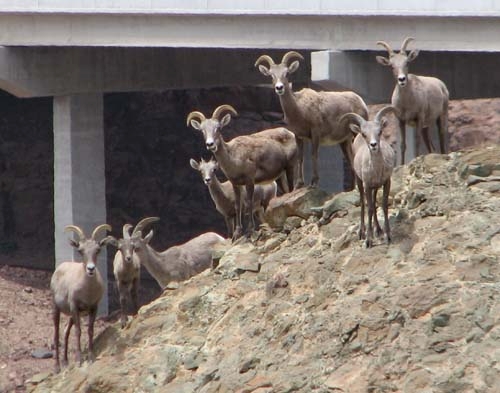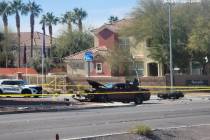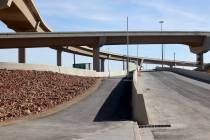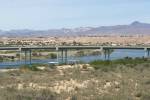Sheep bridges also give humans safe passage
Two decades ago, elected officials in Davis, Calif., agreed to spend $14,000 on a tiny tunnel to safely guide toads across a new road that was built in their habitat.
The taxpayers went bonkers.
The toads didn't use the tunnel initially -- further infuriating the townspeople -- so the city added lighting to lure the critters, which caused an even greater uproar. The heat from the tunnel lamps killed the toads. But design flaws were eventually solved and the toads hopped on through.
Unfortunately, birds discovered the new passage and soon saw the tunnel openings as their very own Pez dispenser.
It's unclear whether the toad tunnels were a success or epic waste of money, but wildlife crossings have become popular features, included in plans for many major roadways. Studies have shown that animal deaths have dropped and the crossings have also saved the lives of motorists.
Here in our state we have dabbled in this. For example, in the northeast, the Nevada Department of Transportation built crossings over U.S. Highway 93 to accommodate mule deer. A University of Nevada, Reno study showed that 7,000 deer used the overpass during two migrations. Nevada also erected little fences along Highway 93 to protect desert tortoises. In that case, the Department of Transportation's efforts were solely to protect the turtles. If a collision were to occur, those tortoises might not do a lot of harm to vehicles or the people inside them.
Bighorn sheep? Different story.
That brings us to those mysterious overpasses on Highway 93 on the Arizona side of the Hoover Dam bypass bridge. Motorists have questioned the purpose of the crossings because there are no exits near them and no roads feeding into them. That is because they weren't built for you entirely; they were mostly constructed for the sheep.
Usually when animals and vehicles are mentioned in the same sentence, the ending to the story is not pretty. In this case, however, it is an uplifting tale about a unusual working relationship between the Arizona Department of Transportation and the Arizona Game and Fish Department.
When plans for the new bypass bridge emerged, Arizona officials -- unlike the state in which we reside -- realized that to avoid creating a nasty bottleneck, the freeway leading up to the four-lane span across the Colorado River should also be widened.
Before the bridge opened a year ago, Highway 93 was a two-lane road that crossed Hoover Dam and then snaked up the canyon. Traffic crept along at a slow tick, and bighorn sheep only had to clear two lanes.
Wildlife experts realized that a four-lane highway with vehicles moving at 80 mph was going to pose a serious safety issue for both drivers and sheep. Putting up fences wasn't a viable solution because the highway separated a significant population of bighorn sheep from the Colorado River, where they sought food, water and shelter.
The highway slices through the Black Mountains, which are home to the largest contiguous herd of desert bighorn sheep.
The Department of Transportation first attempted to coax the sheep across the highway with concrete box culverts, but found that the animals weren't crazy about a darkened pathway where predators could lurk or the straight-edged concrete walls.
Bighorn sheep like to be up high, and transportation and wildlife officials obliged. The result was the first wildlife crossings built in the lower 48 states.
Certainly, like the toad skeptics, not everyone is thrilled with spending money to protect animals. But consider this: The U.S. Department of Transportation says wildlife versus vehicle accidents cause between $5 billion and $8 billion in property damage each year.
Before building the overpasses at a cost of $4.8 million, officials had to determine where the sheep preferred to cross the highway in the 15 miles it stretched through their habitat.
With the help of the Arizona Big Horn Sheep Society, the state spent $130,000 capturing 30 sheep and affixing electronic collars to their necks. Have no fear, the animals aren't married to the collars the rest of their lives; they fall off after two years.
Wildlife officials discovered the herd of about 200 makes the trip to the river by crossing the highway. And with the assistance of the GPS, they figured out where these guys dashed across the road.
Up the crossing went as part of the $71 million widening project, which was mostly funded by the federal government.
"Ultimately it comes down to public safety," said Dustin Krugel, spokesman for Arizona's transportation division. "Wildlife passage structures are frequently used and are a successful method to provide for a safe passage of many wildlife species across roadways. ... These improvements are designed to keep travelers safe as well."
So was this a successful endeavor?
Although cameras mounted on the crossings have captured bighorn sheep using the bridges, it is too early to say whether the number of accidents have decreased, Krugel said. He pointed to a different wildlife crossing project in his state to show that these features are effective.
In 2007, Arizona had a problem with vehicles hitting elk on state Route 260. The state provided tunnels below the roadway, and the number of collisions have dropped 97 percent, Krugel said.
The elk were also fitted with GPS collars, allowing wildlife and transportation experts to track the animals' path. Not only did they learn that the elk indeed use the underpasses, but they also discovered helpful information: You are most likely to hit an elk on state Route 260 two hours after dark on Sundays and Mondays in October or November. Seriously. Take that, toads.
If you have a question, tip or tirade, call Adrienne Packer at 702-387-2904, or send an email to roadwarrior@reviewjournal.com. Include your phone number.
■ Through January, expect round-the-clock lane restrictions on Buffalo Drive between Charleston and Lake Mead boulevards as sidewalk ramps are installed and repairs are made to concrete and asphalt.
■ For the next month, expect major nighttime delays in the northbound lanes of the Airport Connector Tunnel as crews upgrade ceiling-mounted safety lights. Between 8 p.m. and 5 a.m., only one northbound lane will be open to traffic.
■ Through Tuesday, expect intermittent detours north of the Airport Connector Tunnel as concrete is poured for a bridge that will carry traffic from the northbound tunnel to Terminal 3.
■ Through the end of February, expect delays on Tropicana Avenue at Valley View Boulevard because of a sewer project. Left turns from Tropicana at the intersections and some businesses will be restricted intermittently. Lane restrictions also will be in place on Valley View at Tropicana.
■ Through Monday, from 7 a.m. to 3:30 p.m., Lone Mountain Road will be reduced to one lane in each direction between Jones Boulevard and Torrey Pines Drive for a storm drain project.
GASOLINE PRICES
The average price of gasoline in the Las Vegas Valley on Friday was $3.33 per gallon; the current state average is $3.36; the national average is $3.24. Find the Las Vegas Valley's best deals at gasbuddy.com.




























